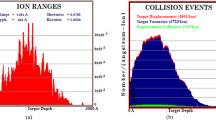Abstract—
Technology has been developed for generating a vapor phase in a separate evaporator at a temperature of 80–120°C by dropping a mixture in a quasi-closed reactor with the help of chemical vapor deposition (CVD). Tin oxide (SnO2) layers were grown on the surface of single-crystal p-Si by chemical vaporization epitaxy and formed a microcrystalline structure on the substrate surface at a temperature of 170–500°C. The study of the spectral dependence of the photosensitivity of the n-SnO2/p-Si heterostructure with an aluminum back contact showed that the inversion of photocurrent photosensitivity occurred associated with the formation of an inbuilt electric field that was generated at the boundary of the frontal electric contact between Al and p-Si and counter connected to the main potential barrier of the n-SnO2/p-Si heterojunction.





Similar content being viewed by others
REFERENCES
Chen, X., Liang, J., Zhou, Z., et al., The preparation of SnO2 film by electrodeposition, Mater. Res. Bull., 2010, vol. 45, no. 12, pp. 2006–2011. https://doi.org/10.1016/j.materresbull.2010.07.029
Korotkov, R.Y., Ricou, P., Farran, A.J.E., Preferred orientations in polycrystalline SnO2 films grown by atmospheric pressure chemical vapor deposition, Thin Solid Films, 2006, vol. 502, nos. 1–2, pp. 79–87. https://doi.org/10.1016/j.tsf.2005.07.248
Ruske, M., Bräuer, G., Pistner, J., et al., Properties of SnO2 films prepared by DC and MF reactive sputtering, Thin Solid Films, 1999, vol. 351, nos. 1–2, pp. 146–150. https://doi.org/10.1016/S0040-6090(99)00083-8
Leng, D., Wu, L., Jiang, H., et al., Preparation and properties of SnO2 film deposited by magnetron sputtering, Int. J. Photoenergy, 2012, vol. 2012, art. id. 235971. https://doi.org/10.1155/2012/235971
Hsu, P.C., Hsu, C.J., Chang, C.-H., et al., Sputtering deposition of P-type SnO films with SnO2 target in hydrogen-containing atmosphere, ACS Appl. Mater. Interfaces, 2014, vol. 6, no. 16, pp. 13724–13729. https://doi.org/10.1021/am5031787
Lee, S.U., Choi, W.S., and Hong, B., Synthesis and characterization of SnO2: Sb film by dc magnetron sputtering method for applications to transparent electrodes, Physica Scripta, 2007, vol. T129, pp. 312–315. https://doi.org/10.1088/0031-8949/2007/T129/069
Cachet, H., Bruneaux, J., Folcher, G., et al., n‑Si/SnO2 junctions based on macroporous silicon for photoconversion, Sol. Energy Mater. Sol. Cells, 1997, vol. 46, no. 2, pp. 101–114. https://doi.org/10.1016/S0927-0248(96)00095-5
Chen, Z., Lai, J., Shek, C.H., and Chen, H.D., Nucleation and growth of SnO2 nanocrystallites prepared by pulsed laser deposition, Appl. Phys. A, 2005, vol. 81, no. 5, pp. 959–962. https://doi.org/10.1007/s00339-004-3099-7
Chan y Díaz, E., Duarte-Moller, A., Camacho, J.M., and Castro-Rodríguez, R., SnO2 thin films grown by pulsed Nd:YAG laser deposition, Appl. Phys. A, 2012, vol. 106, no. 3, pp. 619–624. https://doi.org/10.1007/s00339-011-6630-7
Songqing, Z., Yueliang, Z., Shufang, W., et al., Effect of ambient oxygen pressure on structural, optical and electrical properties of SnO2 thin films, Rare Met., 2006, vol. 25, no. 6, pp. 693–696. https://doi.org/10.1016/S1001-0521(07)60014-X
Serin, T., Serin, N., Karadeniz, S., et al., Electrical, structural and optical properties of SnO2 thin films prepared by spray pyrolysis, J. Non-cryst. Solids, 2006, vol. 352, no. 3, pp. 209–215. https://doi.org/10.1016/j.jnoncrysol.2005.11.031
Boshta, M., Mahmoud, F.A., and Sayed, M.H., Characterization of sprayed SnO2: Pd thin films for gas sensing applications, J. Ovonic Res., 2010, vol. 6, no. 2, pp. 93–98. http://www.chalcogen.ro/index.php/journals/journal-of-ovonic-research/12-jor/251-volume-6-number-2-march-april-2010
Gu, Z., Liang, P., Liu, X., et al., Characteristics of sol–gel SnO2 films treated by ammonia, J. Sol–Gel Sci. Technol., 2000, vol. 18, no. 2, pp. 159–166. https://doi.org/10.1023/A:1008769020768
Atabaev, I.G., Hajiev, M.U., Pak, V.A., et al., Growth of transparent electrical conducting films of indium and tin oxides by chemical vapor deposition, Appl. Sol. Energy, 2016, vol. 52, no. 2, pp. 103–106. https://doi.org/10.3103/S0003701X16020079
Atabaev, I.G., Khazhiev, M.U., Pak, V.A., and Zakirova, S.B., RUz Patent IAP 05674, 2018.
He, B., Xu, J., Xing, H., et al., Observation of nanospherical n-SnO2/p-Si heterojunction fabricated by ultrasonic spray pyrolysis technique, Surf. Rev. Lett., vol. 20, no. 5, art. id. 1350052. https://doi.org/10.1142/S0218625X13500522
Razykov, T.M., Bosio, A., Ergashev, B., et al., Growth and characterization of ZnxSn1 – xSe films for use in thin film solar cells, Sol. Energy, 2019, vol. 193, pp. 519–522. https://doi.org/10.1016/j.solener.2019.09.072
Yuan, Z., Li, D., Wang, M., et al., Electroluminescence of SnO2/p-Si heterojunction, J. Appl. Phys. Lett., 2008, vol. 92, art. id. 121908.
Kabulov, R.R., Features of the buffer layer ZnxCd1 – xS for use in thin-film solar cells, Appl. Sol. Energy, vol. 56, no. 5, pp. 383–387, 2020. https://doi.org/10.3103/S0003701X20050096
Approx Band Offsets: Robertson JAP 2006. http://ematsolar.lbl.gov/images. CRC Workfns. http://www.hbcpnetbase.com/articles/12_21_86.pdf. Accessed December 22, 2020.
Saidov, M.S., Khazhiev, M.U., Kobulov, R., Gulyamov, A.G., Zhuraev, Kh.N., and Saidov, D.Sh., Some electrical properties of p-Si/n-SnO2 heterostructures obtained on Si substrates, Dokl. Akad. Nauk, 2020, no. 2, pp. 21–25.
Funding
This work was financially supported by the Ministry of Innovation Development of the Republic of Uzbekistan as part of fundamental project FA-FA-F-2-005.
Author information
Authors and Affiliations
Corresponding author
Additional information
Translated by S. Kuznetsov
About this article
Cite this article
Khazhiev, M.U., Kabulov, R.R., Gulyamov, A.G. et al. Study of n-SnO2/p-Si Heterostructures Fabricated by Chemical Vapor Deposition Methods. Appl. Sol. Energy 57, 30–33 (2021). https://doi.org/10.3103/S0003701X21010114
Received:
Revised:
Accepted:
Published:
Issue Date:
DOI: https://doi.org/10.3103/S0003701X21010114




